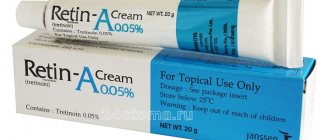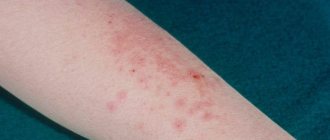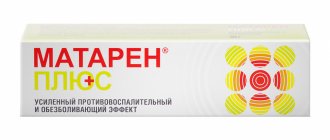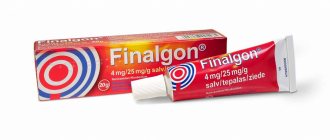Pharmacodynamics and pharmacokinetics
The active component of the drug, Flumethasone , is a synthetic bifluorinated corticosteroid intended for external use. The substance has anti-inflammatory , antiallergic , antipruritic , decongestant and vasoconstrictor effects. By acting on the skin, the drug helps prevent the marginal accumulation of neutrophils , reducing inflammatory exudate and the production of lymphokines, inhibits the migration of macrophages, reduces the processes of infiltration and granulation, and so on.
Clioquinol or iodochlorooxyquinoline is a derivative of 8-hydroxyquinolines. Its activity is manifested against yeast fungi, dermatophytes, and gram-positive bacteria. In addition, the antiexudative effect of Flumethasone .
The combined effect of Flumethasone and Clioquinol suppresses the development of various inflammatory and allergic reactions on skin surfaces, which can be complicated by bacterial or fungal infections.
Thanks to its fatty base, the ointment has a softening and water-repellent effect, which is provided by a protective film that protects the skin from moisture. This drug is suitable for use by patients with dry and thin skin.
After applying the product to the skin, its active substances penetrate the stratum corneum. In this case, flumethasone pivalate is not absorbed into the bloodstream and does not have a systemic effect. Increased absorption occurs as a result of frequent use of the ointment or its application to large areas of the skin. This can also be expected when using the product on the face, in skin folds, in places of damage to the epidermis, under an occlusive dressing. It should be noted that in children the effect of the substance is especially pronounced. Clioquinol in the ointment is absorbed through the skin, binding to blood plasma proteins.
The active substances are slightly metabolized in the skin structure. Mostly this process occurs in the liver. The components are then excreted from the body in urine or bile.
Pharmacodynamics
Due to flumethasone, it has a pronounced anti-inflammatory, antiallergic, and antipruritic effect. Reduces permeability and changes the structure of tissue and cell membranes, reduces the migration of macrophages and lymphocytes, affects all phases of inflammation, blocks the release of histamine and other biologically active substances from sensitized mast cells and basophils. The clioquinol contained in the composition causes antimicrobial activity (against most gram-positive and gram-negative bacteria and fungi), and also enhances the antiexudative effect of flumethasone.
Contraindications for use
This drug is not prescribed for:
- skin tuberculosis;
- viral skin lesions, such as chickenpox or herpes ;
- syphilis with manifestations on the skin;
- precancerous conditions and skin tumors;
- perioral dermatitis ;
- period after vaccination;
- acne;
- trophic ulcers caused by varicose veins ;
- under 10 years of age;
- hypersensitivity.
Directions for use and doses
Externally. The ointment is applied in a thin layer to the affected areas of the skin, at the beginning of treatment - 2-3 times a day, when positive dynamics appear - 1-2 times a day; Duration of use - no more than 2 weeks. If necessary, use a bandage that allows air to pass through. In case of excessive lichenification and hyperkeratosis - only under an occlusive dressing once every 24-48 hours, for no more than 1 week.
Unnecessarily, you should not use more than 2 g of ointment per day.
In adolescents over 10 years of age - only in exceptional cases, on limited areas of the skin, avoiding applying the drug to the skin of the face.
Side effects
The use of the drug Lorinden C can cause: burning, stretch marks, folliculitis , itching and dry skin. Long-term use leads to the development of: purpura, skin atrophy , telangiectasia, pigmentation disorders, local hirsutism . When the product is applied to large areas for a long time, side effects characteristic of GCS may occur.
Lorinden® A
The course of continuous therapy is no more than 2 weeks.
Avoid contact of Lorinden® A ointment with the eyes and mucous membranes. If, when using Lorinden® A ointment externally, there are signs of irritation, increased dry skin or allergies, as well as increased side effects or effects not specified in the instructions, you should stop treatment and consult a doctor.
With long-term use and/or application to large surfaces of the skin, wounds, damaged skin, the use of large doses, when using occlusive dressings and when treating children with Lorinden® A ointment, systemic absorption of glucocorticosteroid and salicylic acid is possible; it is possible to suppress the function of the hypothalamic-pituitary-adrenal system and develop symptoms of hypercortisolism.
During drug therapy, periodic monitoring of the function of the adrenal cortex is necessary by determining the concentration of cortisol in the blood and urine after stimulation of the adrenal glands with adrenocorticotropic hormone (ACTH).
In case of development of a secondary bacterial or fungal infection, it is necessary to prescribe external use of an antibacterial or antifungal drug. If symptoms of infection persist, you should stop using Lorinden® A until the infection has resolved.
Lorinden® A should be used with caution on the skin around the eyes or eyelids due to the risk of developing glaucoma or cataracts, as well as in patients with a history of these diseases, who may experience an exacerbation of these diseases.
Lorinden® A should be used with extreme caution on the skin of the face and intertriginous skin (skin folds, armpits, groin area, crooks of the arms and legs), due to increased absorption of glucocorticosteroids through thin skin and the possibility of side effects (telangiectasia, skin atrophy , perioral dermatitis) even after short-term use.
The drug Lorinden® A is used with caution under an occlusive dressing due to increased absorption of glucocorticosteroids into the blood; since atrophy of the epidermis, striae and infection may develop.
The drug should be used with caution in case of atrophic changes in the subcutaneous tissue, especially in the elderly.
Lorinden® A should be used with extreme caution in patients with psoriasis, due to the possible relapse of the disease caused by the development of tolerance, the risk of generalized pustular psoriasis and general toxicity due to pressure ulcers.
Children and teenagers
Lorinden® A ointment should be used with caution, especially as long-term therapy, in children over 2 years of age, since in this group of patients, due to a higher ratio of body surface area to body weight than in adults, dysfunction may develop more quickly hypothalamic-pituitary-adrenal system and undesirable effects characteristic of glucocorticosteroids may occur, including growth and development retardation.
Propylene glycol, lanolin and salicylic acid contained in Lorinden® A may cause irritation at the site of application, including allergic reactions (for example, contact dermatitis).
Interaction
The simultaneous use of Lorinden S and other external agents is not permissible. When the drug is applied to large areas of the skin, the absorption of Flumethasone can reduce the effect of insulin , other hypoglycemic agents, antihypertensive drugs and anticoagulants. In addition, the risk of negative effects of anticholinergic drugs, anabolic steroids, oral contraceptives, androgens, estrogens, antipsychotics, azathioprine , bucarban, diuretics, nitrates, tricyclic antidepressants, antihistamines, cardiac glycosides increases. The immunosuppressive effect of this drug requires refraining from vaccinations and immunizations.
Analogs
In modern pharmacology, there are analogues of this drug: Flumethasone, Lorinden, Lorinden A. Drugs similar in action include: Dexamethasone, Prednisolone, Diprospan, Methylprednisolone , etc.
Reviews of Lorinden S
As reviews of Lorinden S show, this external remedy is one of the most popular. It is prescribed for a wide variety of skin lesions, and in most cases, it turns out to be very effective.
However, some patients report that the positive effect of the drug lasts only for a while, that is, it simply inhibits the development of unwanted symptoms. After stopping the use of Lorinden S, patients begin to experience the same disorders again.
According to experts, this treatment result was noted when prescribing an external remedy without sufficient examination by specialists, since often people do not even know exactly what Lorinden S ointment is for. Also, many reviews of the ointment contain information that patients often use the drug on their own without contacting to the doctor. Therefore, in such cases, one should not exclude either a temporary cessation of the symptoms of the disease or the development of all kinds of side effects.
Lorinden S 15g ointment
Lorinden with 15g ointment
Lorinden S is an external drug with antimicrobial, antipruritic, antiallergic and anti-inflammatory effects.
Release form and composition
Lorinden S is produced in the form of an ointment: oily, white with a gray or light yellow tint (in aluminum tubes of 15 g, 1 tube in a cardboard box). The composition of 100 mg ointment includes active substances: Flumethasone pivalate – 0.02 mg; Clioquinol – 3 mg. Auxiliary components: white beeswax – 1 mg, petroleum jelly – up to 100 mg.
Indications for use
Lorinden S is prescribed for the treatment of the following allergic dermatoses complicated by bacterial infection, which are caused by microorganisms sensitive to the action of the drug: Dermatitis, including seborrheic, occupational, solar, contact, allergic; Atopic dermatitis (common neurodermatitis); Psoriasis (especially old cases, including psoriasis of the scalp); Hives; Eczema; Erythroderma; Erythema multiforme; Pruritus; Dermatoses that cannot be treated with glucocorticosteroids, including lichen planus, discoid lupus erythematosus; Secondary infections from insect bites. Lorinden C is also used in the treatment of bacterial and fungal skin infections complicated by the development of local allergic reactions, including infected diaper rash, impetigo, dermatomycosis, blastomycosis, actinomycosis, sporotrichosis.
Contraindications
Viral skin diseases, including chickenpox, herpes; Skin infections (for use with occlusive dressing); Skin manifestations of syphilis; Lupus; Perioral dermatitis; Precancerous conditions and skin neoplasms (atheroma, nevus, skin cancer, melanoma, epithelioma, xanthoma, hemangioma, sarcoma); Acne (rosacea and vulgaris); Trophic ulcers of the legs associated with varicose veins; Condition after vaccination; Age up to 10 years; Hypersensitivity to the components of the drug. The use of Lorinden S in the first trimester of pregnancy is contraindicated. At later stages, the drug can be used only after assessing the benefit/risk ratio for the health of the mother and fetus. When prescribing the drug to breastfeeding women, caution should be exercised. Treatment should be carried out short-term only in exceptional cases, applying the ointment to limited skin areas (excluding areas of the mammary glands).
Directions for use and dosage
Lorinden S is used externally, applying a thin layer to the affected areas of the skin. At the beginning of treatment, the drug is used up to 3 times a day; after the condition improves, the frequency of application is reduced to 1-2 times a day. The maximum dose is 2 g per day. Lorinden S should not be used for longer than 14 days. If it is necessary to use ointment with a bandage, it is necessary to use air-permeable bandages. For hyperkeratosis and excessive lichenification, the ointment is used only under occlusive dressings once every 24-48 hours. In these cases, the duration of therapy should not exceed 7 days. In children over 10 years of age, Lorinden C can be used only on limited areas of the skin in exceptional cases, avoiding applying the drug to the facial skin.
Side effects
Systemic reactions: with prolonged therapy and/or use on large areas of the skin - disorders characteristic of the use of glucocorticosteroids; Local reactions: rarely - folliculitis, dry skin, itching, burning, stretch marks, steroid acne; with prolonged therapy - purpura, local hirsutism, skin atrophy, telangiectasia, pigmentation disorders. Special instructions It is not recommended to apply Lorinden S to the skin of the face; you should also avoid getting the ointment in the eyes. You should not use the drug for longer than the recommended period, since long-term use of Lorinden S on large areas of the skin increases the risk of systemic side effects of glucocorticosteroids. With prolonged therapy, microflora may develop resistance to the action of the active substance of the drug (clioquinol). In cases of secondary infections developing at the site of application of the drug, it is necessary to use agents with a more pronounced antifungal or antibacterial effect. For atrophic skin changes, especially in elderly patients, Lorinden S should be used with caution. For fungal diseases with secondary allergic reactions, the ointment should be used under medical supervision in exceptional cases. Drug interactions Due to the immunosuppressive effect of Lorinden S, immunization and vaccination should not be carried out during therapy. Simultaneous use with other external drugs is not recommended. When Lorinden C is absorbed into the systemic circulation, the effectiveness of anticoagulants, antihypertensive drugs, insulin, and oral hypoglycemic agents decreases, and the concentration of praziquantel and salicylates in the blood serum decreases. With simultaneous use, the risk of developing side effects of estrogens, androgens, anticholinergics, oral contraceptives, anabolic steroids, antipsychotics, bucarban, tricyclic antidepressants, azathioprine, antihistamines, diuretics, nitrates, cardiac glycosides increases. Analogs Analogs of Lorinden C are: Flumethasone, Lorinden, Lorinden A, Dexamethasone, Prednisolone, Diprospan, Methylprednisolone.
Terms and conditions of storage
Store out of reach of children at temperatures up to 25°C. Shelf life – 3 years.
Conditions for dispensing from pharmacies
Dispensed by prescription.
Lorinden S price, where to buy
In Moscow pharmacies, the price of Lorinden C ointment for external use varies between 242-308 rubles.
- Online pharmacies in RussiaRussia
- Online pharmacies in UkraineUkraine
- Online pharmacies in KazakhstanKazakhstan
ZdravCity
- Lorinden S ointment 15gJelfa SA
RUR 479 order
Pharmacy Dialogue
- Lorinden S (ointment tube 15g)Jelfa
RUR 492 order
show more
Pharmacy24
- Lorinden C 15 g ointment Farmzavod Elfa A.T., Poland
111 UAH order
PaniPharmacy
- Lorinden C ointment Lorinden C ointment 15g Poland, Jelfa
126 UAH order
show more



